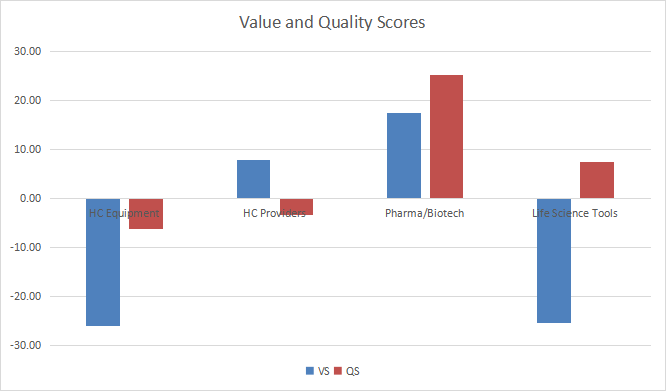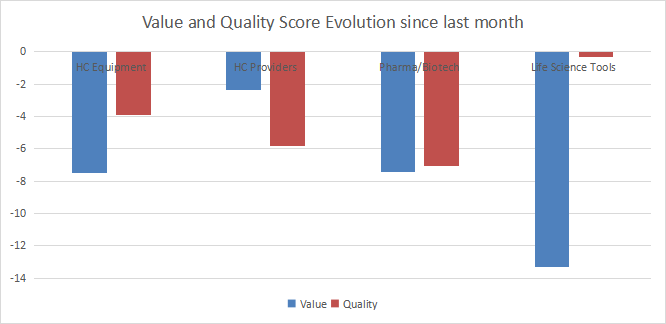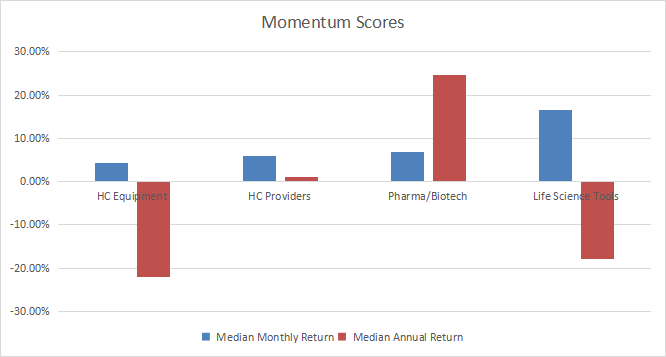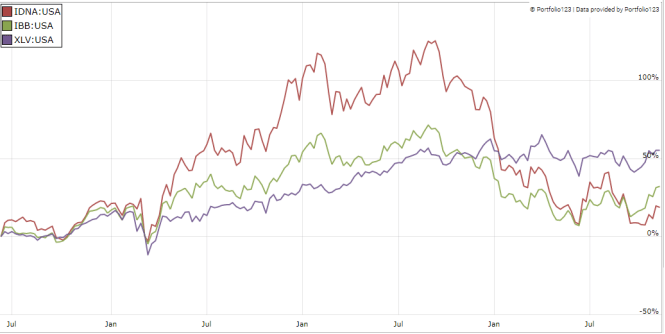janiecbros
This monthly article series shows a dashboard with aggregate industry metrics in healthcare. It also may serve as a top-down analysis of sector ETFs like the iShares U.S. Healthcare ETF (IYH) and the Health Care Select Sector SPDR ETF (XLV), whose largest holdings are used to calculate these metrics.
Shortcut
The next two paragraphs in italic describe the dashboard methodology. They are necessary for new readers to understand the metrics. If you are used to this series or if you are short of time, you can skip them and go to the charts.
Base Metrics
I calculate the median value of five fundamental ratios for each industry: Earnings Yield (“EY”), Sales Yield (“SY”), Free Cash Flow Yield (“FY”), Return on Equity (“ROE”), Gross Margin (“GM”). The reference universe includes large companies in the U.S. stock market. The five base metrics are calculated on trailing 12 months. For all of them, higher is better. EY, SY and FY are medians of the inverse of Price/Earnings, Price/Sales and Price/Free Cash Flow. They are better for statistical studies than price-to-something ratios, which are unusable or non available when the “something” is close to zero or negative (for example, companies with negative earnings). I also look at two momentum metrics for each group: the median monthly return (RetM) and the median annual return (RetY).
I prefer medians to averages because a median splits a set in a good half and a bad half. A capital-weighted average is skewed by extreme values and the largest companies. My metrics are designed for stock-picking rather than index investing.
Value and Quality Scores
I calculate historical baselines for all metrics. They are noted respectively EYh, SYh, FYh, ROEh, GMh, and they are calculated as the averages on a look-back period of 11 years. For example, the value of EYh for healthcare providers in the table below is the 11-year average of the median Earnings Yield in this industry.
The Value Score (“VS”) is defined as the average difference in % between the three valuation ratios (EY, SY, FY) and their baselines (EYh, SYh, FYh). The same way, the Quality Score (“QS”) is the average difference between the two quality ratios (ROE, GM) and their baselines (ROEh, GMh).
The scores are in percentage points. VS may be interpreted as the percentage of undervaluation or overvaluation relative to the baseline (positive is good, negative is bad). This interpretation must be taken with caution: the baseline is an arbitrary reference, not a supposed fair value. The formula assumes that the three valuation metrics are of equal importance.
Current data
The next table shows the metrics and scores as of last week's closing. Columns stand for all the data named and defined above.
| VS | QS | EY | SY | FY | ROE | GM | EYh | SYh | FYh | ROEh | GMh | RetM | RetY | |
| HC Equipment | -26.09 | -6.09 | 0.0277 | 0.2210 | 0.0190 | 11.27 | 67.41 | 0.0331 | 0.2777 | 0.0325 | 13.86 | 63.26 | 4.22% | -22.15% |
| HC Providers | 7.97 | -3.35 | 0.0525 | 1.4484 | 0.0773 | 17.69 | 20.02 | 0.0526 | 1.4367 | 0.0627 | 15.92 | 24.37 | 5.97% | 1.13% |
| Pharma/Biotech | 17.59 | 25.29 | 0.0500 | 0.2168 | 0.0453 | 32.30 | 79.04 | 0.0374 | 0.2481 | 0.0344 | 21.17 | 80.66 | 6.92% | 24.75% |
| Life Science Tools | -25.48 | 7.59 | 0.0283 | 0.1746 | 0.0212 | 17.16 | 59.15 | 0.0299 | 0.2885 | 0.0310 | 15.89 | 55.18 | 16.55% | -17.79% |
Value and Quality chart
The next chart plots the Value and Quality Scores by industry (higher is better).

Value and quality in healthcare (Chart: author; data: Portfolio123)
Evolution since last month
The value score has deteriorated in all subsectors, the most in life science tools. Quality scores are also down.

Variations in value and quality (Chart: author; data: Portfolio123)
Momentum
The next chart plots momentum data.

- Pfau, Wade (Author)
- English (Publication Language)
- 508 Pages - 03/15/2023 (Publication Date) -...
- Birken, Emily Guy (Author)
- English (Publication Language)
- 240 Pages - 05/11/2021 (Publication Date) - Adams...
- Amazon Kindle Edition
- Holt, Richard (Author)
- English (Publication Language)
- 172 Pages - 07/19/2022 (Publication Date)
Last update on 2024-04-05 / Affiliate links / Images from Amazon Product Advertising API
Momentum in healthcare (Chart: author; data: Portfolio123)
Interpretation
Pharma/biotech has been the best-ranked healthcare subsector in both value and quality scores for many months. Now it's undervalued by 17.6% relative to 11-year averages. It's also far above the quality baseline. Healthcare providers are undervalued by about 8%, and they are close below their quality baseline. Life science tools and healthcare equipment are overvalued by about 25% relative to the baseline. The former has a good quality score, but not high enough to justify such overvaluation.
Fast facts on IDNA
Genomics is one of the most promising fields in the pharma/biotech industry. The iShares Genomics Immunology and Healthcare ETF (NYSEARCA:IDNA) provides exposure to innovative companies in genomics, immunology and bioengineering. Its total expense ratio is similar to the iShares Biotechnology ETF (IBB): 0.47% vs. 0.44%. Both are significantly above the sector benchmark XLV (0.10%).
As defined in the prospectus by iShares,
The Fund seeks to track the investment results of the NYSE® FactSet® Global Genomics and Immuno Biopharma IndexTM (the “Underlying Index”), which measures the performance of equity securities issued by companies in the biopharmaceutical and healthcare equipment and services industries that could benefit from the long-term growth and innovation in genomics, immunology and bioengineering (…). Companies must have equal to or greater than 50% of their revenue from one or more selected Level 6 industries, as defined by the FactSet Revere Business Industry Classification System (“RBICS”).
IDNA holds 42 stocks: 65% of asset value is in the U.S., 21% in Europe and 14% in Asia. The portfolio is quite concentrated: the aggregate weight of the top 10 holdings is 47% (list below).
| Ticker | Name | Weight% | EPS growth %ttm | P/E ttm | P/E fwd | Yield% |
| BGNE* | BeiGene Ltd. | 5.88 | -51.14 | N/A | N/A | 0 |
| GMAB | Genmab A/S | 5.6 | 46.42 | 47.65 | 32.98 | 0 |
| MRNA | Moderna, Inc. | 5.33 | 69.84 | 6.71 | 8.38 | 0 |
| GILD | Gilead Sciences, Inc. | 5.15 | -54.90 | 31.39 | 11.72 | 3.52 |
| BEAM | Beam Therapeutics, Inc. | 4.84 | 32.06 | N/A | N/A | 0 |
| NTLA | Intellia Therapeutics, Inc. | 4.3 | -74.93 | N/A | N/A | 0 |
| REGN | Regeneron Pharmaceuticals, Inc. | 4.26 | -24.26 | 15.36 | 16.90 | 0 |
| BNTX | BioNTech SE | 4.09 | 171.09 | 2.98 | 4.53 | 0 |
| OTCQX:RHHBY* | Roche Holding AG | 3.68 | 6.23 | 17.39 | 15.63 | 2.98 |
| TAK* | Takeda Pharmaceutical Co., Ltd. | 3.67 | -62.01 | 25.64 | 19.37 | 5.29 |
*U.S. ticker for convenience. The fund holds shares in primary exchanges.
Since inception (06/11/2019), IDNA has underperformed the sector benchmark XLV and the industry benchmark IBB (see next chart). However, it has performed better until Q3 2021. Price history is too short to assess the strategy on past performance, but it's obvious that IDNA is very risky regarding drawdown and volatility.

IDNA vs XLV and IBB since June 2019 (Chart: Portfolio123)
Dashboard List
I use the first table to calculate value and quality scores. It also may be used in a stock-picking process to check how companies stand among their peers. For example, the EY column tells us that a large pharma/biotech company with an Earnings Yield above 0.05 (or price/earnings below 20) is in the better half of the industry regarding this metric. A Dashboard List is sent every month to Quantitative Risk & Value subscribers with the most profitable companies standing in the better half among their peers regarding the three valuation metrics at the same time. The list below was sent to subscribers several weeks ago based on data available at this time.
| ABC | AmerisourceBergen Corp. |
| MRNA | Moderna, Inc. |
| DVA | DaVita, Inc. |
| VIR | Vir Biotechnology, Inc. |
| ITOS | iTeos Therapeutics, Inc. |
| THC | Tenet Healthcare Corp. |
| PFE | Pfizer Inc. |
| ORGO | Organogenesis Holdings, Inc. |
| IRWD | Ironwood Pharmaceuticals, Inc. |
| QDEL | QuidelOrtho Corp. |
It's a rotating list with a statistical bias toward excess returns on the long-term, not the result of an analysis of each stock.




